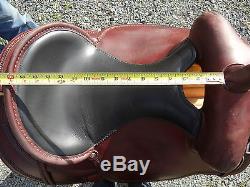
If you’re searching for the perfect mix of efficiency and ease, you’ll find it in the Cashel Lite Trail Saddle CLT. Best Lightweight Western Trail Saddles – Cashel Lite Trail Saddle CLT Now keep in mind, just as cheap doesn’t always mean poor quality, expensive doesn’t necessarily mean it will be a good fit for you and your horse.īut I think The Cashel Lite Trail Saddle CLT is an exception. Let’s take a look at my next pick for a lightweight Western saddle trail, which is a bit more expensive. Built on Ralide Tree (which makes it super lightweight), with 7/8 position, leather reinforced half-breed rigging stainless steel hardware. Shock absorbing foam for a comfortable ride. The foam and denier nylon are water resistant. The outer shell of the Abetta Sublime Super Cushion Trail Saddle 20500 is made with tough, scratch resistant, 1000-denier nylon, which is laminated to shock absorbing Super Cushion Memory Foam for a comfortable seat. Best Lightweight Western Trail Saddles – What Materials Are Used? And when you sew the parts on to cover the mold, it fits like a glove – always.Ībetta makes trees to shape many breeds, including draft and gaited horses. What’s great about using a molded tree is that each saddle comes out perfectly. Best Lightweight Western Trail Saddles – Is a Molded Tree Good? It’s used for making food containers, plastic bags and other kinds of packaging that require durability. Polyethylene is a tough, light, flexible synthetic resin. So let’s start with one of my favorites – Abetta Saddles.Best Lightweight Western Trail Saddles Best Lightweight Western Trail Saddles – Abetta Sublime Super Cushion Trail Saddle 20500Ībetta uses Ralide tree in this particular trail saddle. That being said, I have to say when looking for some of the best lightweight Western saddles, “lightweight” is relative.Ĭonsidering some Western saddles can weigh up to 60 pounds, a saddle that weighs between 17 and 25 pounds is definitely considered lightweight. Horse saddle manufacturers such as Abetta, Cashel and Circle Y (and a whole host of other manufacturers) are stepping up to the plate, offering many options for lightweight Western trail saddles. Best Lightweight Western Trail Saddles – So What’s The Solution?įortunately, quite a few saddleries have and continue to cater to the needs of trail riders.

While a minor imperfection in an arena saddle may have zero (or very minor) consequences because you’re only going to be sitting in the saddle for an hour, that same imperfection can cause significant soreness for both you and your horse after riding all day on a trail over various terrain. Once you’ve zeroed in on a few models, you’ll focus on fit.įit is important because the more time you spend in a saddle, the more good fit becomes a critical factor.

You’ll also focus on design in your initial considerations. Initially, you’ll look for the quality of materials in a trail saddle. Best Lightweight Western Trail Saddles – Why Is Fit So Important? I’ve decided to make the task a little easier for you by listing a few of (in my humble opinion) some of the best lightweight Western trail saddles on the market, and what you should look for in a trail saddle. What should you look for? What kind of material should they be made from? So how do you choose one? Looking for the best lightweight Western trail saddles on the market can sometimes be difficult. They’re designed to keep you and your horse comfortable over miles on the trail.

I suppose you can take your pick.Western trail saddles. It’s difficult to know just where and how the tree got its name. Of course, I’ve seen accounts that directly contradict this, often from the same source. Also coincidentally, the name sequoia itself narrowly won out over the common British name Wellingtonia, which the British still use. As far as I can tell, a scientist named a compound that was distilled from sequoia leaves “se-quoi-ene,” which later became the basis for the name sequoia. Coincidentally, the sequoia tree was not named after Sequoyah. It actually refers to a Cherokee chief who developed a written alphabet for the Cherokee language, which later led to skyrocketing literacy rates among pre-literate Cherokees. At the end of this descent, you will emerge at the base of a massive sequoia that has been dubbed “Chief Sequoyah.” The misspelling is not an accident. From here, the trail will descend down the west side of this ridge and back into dense sequoia forest.

It also marks the halfway point of the hike.


 0 kommentar(er)
0 kommentar(er)
